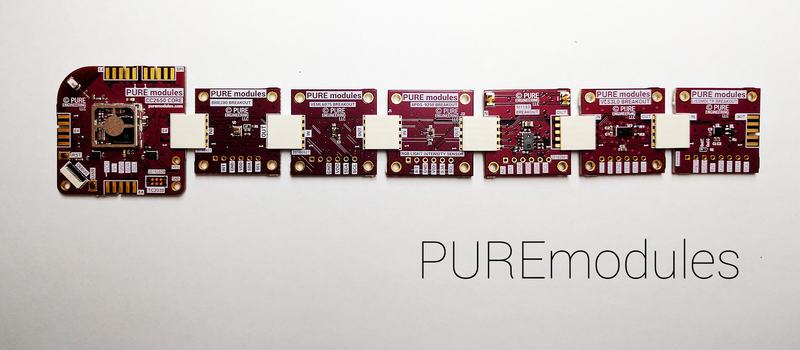[Sashi]’s PURE modules system wants your next wireless microcontroller and sensor module project to be put together using card-edge connectors. But it’s a lot deeper than that — PURE is an entire wireless gadget development ecosystem. Striking a balance between completeness and modularity is very difficult; a wire can carry any imaginable electronic signal, but just handing someone a pile of wires presents them a steep learning curve. PURE is at the other end of the spectrum: everything is specified.
So far, two microcontroller options are available in the system, the nRF52 series and TI’s CC2650. Both of these run the Contiki OS, so it doesn’t matter which of these you choose. Wired data is all transmitted over I2C and connects up via the previously-mentioned card-edge connectors. On the wireless side, data transport is handled through an MQTT broker, using the MQTT-sn variant which is better suited to small radio devices. At the protocol layer everything uses Protocol Buffers, Google’s newest idea for adding some structure to the data.
 What all this means is that it should be very easy to get code, devices, and WiFi-connected computers and services all working together. Besides the overview available at Hackaday.io, there are hardware and software repositories on GitHub, and [Sashi] even put together an Instructable to get you started making your own modules. It’s also up on Kickstarter at the moment, so check that out if you’re not feeling DIY.
What all this means is that it should be very easy to get code, devices, and WiFi-connected computers and services all working together. Besides the overview available at Hackaday.io, there are hardware and software repositories on GitHub, and [Sashi] even put together an Instructable to get you started making your own modules. It’s also up on Kickstarter at the moment, so check that out if you’re not feeling DIY.
PURE uses current open-source and interoperable technologies at every step of the way, coming together into what looks like a well thought-out system. Will something like this help you escape the connector zoo that characterizes our modern hacking scene? We have no idea, but it looks like a totally reasonable fifteenth standard.
















Hey, It’s Christmas, PURE looks like wireless circuit LEGO… and who doesn’t like LEGO for Christmas? Only thing missing – a version with an ESP8266.
PS to Elliot – my Christmas gift to myself was your MAKE: AVR Programming book. I’m enjoying it.
An ESP32 version is in progress, don’t worry :)
Also been experimenting with making it Lego compatible. A preview of the latest variant is here.
https://twitter.com/PureEngineerLLC/status/792177627389841408
It probably fills some niche. It’s also a standard, but just like all the others it has its own set of flaws/limitations, like being I2C only. That’s quite restrictive in my book, and I’ll happily take the mess-o-wires and breakout boards over this. Feel free to disagree, I won’t think any less of you! With wires I also get SPI, parallel interfaces, edge triggered interrupts, ADCs and everything else. It seems like they have basic inter-board communication going here but that’s about it. Perhaps they just envisioned people using it as some sort of IoT-esque sensor network, hence the MQTT. I dunno…
Merry Christmas and holidays to everyone!
check out the SPI variant here: http://www.pureengineering.com/projects/modularsensor
I’ll just drop this here https://xkcd.com/927/
Neat! We already use the PURE carriers for the Hammatsu C12880MA spectrometers. I’ll need to check these out, since we can definitely use a low cost wireless solution for some of our stuff.
Thank for the Feedback, BTW, anyone interested in the C12880MA sensor here is a link: https://groupgets.com/manufacturers/hamamatsu-photonics/products/c12880ma-micro-spectrometer
Also listed there is a Grid-Eye thermal Camera PUREmodule if anyone is interested. https://groupgets.com/campaigns/259-grid-eye-thermal-camera-puremodule
Pure… After working with a computer named CHIP and confusing everybody in communication about the project, i’m waiting for electronics called “the”,”stuff”, “part” or “thing”
Isn’t this the same concept encountered in the recently UNDERFUNDED “Arduino” kickstarter campaign?
The Arduino project had a custom i2c protocol, and an AVR per sensor module. This would drive up the cost and complexity. Also this defeated the point for this system to make it a prototype system that closely matches actual hardware.
So can someone explain to a not-a-hardware-guy the differences between this approach and Arduino shields? In the video, they show one of the PURE modules being adapted to act somewhat like a shield. Again, I’m not trying to be critical of the concept here, just trying to understand what it is and how it fits into the ecosystem.
The modules are essentially easy to work with, low cost sensor modules. They can plug into a PUREmodules compatible controller, or an Arduino, up to the user. The Problem with Arduino Shields is that they are large, and tend to be more expensive to make due to their larger size and large connector, plus they only work with Arduino Bases. if you want to breadboard it its not going to plug into one.
Take for example you want to build a breakout board for just one tiny 2x2mm QFN part. it would nice if you can use a low cost square inch pcb for a few $, along with a few support parts and call it done. if you use the PCB edge connector, you don’t even have to mess with soldering a header in and its even cheaper.
Also say you want to make something you want to use, its much nicer if it is small enough to carry around. A large stack of Arduino Shields is going to be very large. Say you want to instrument your arm with sensors, what would you rather collect data with.
Thanks, that makes lots of sense!